UP Board Class 9 Science Notes For Chapter 8 Force And Laws Of Motion
In our everyday life, we observe that some efforts are required to put a stationary object into motion or to stop a moving object. We ordinarily experience this as a muscular effort and say that we must push, hit, or pull on an object to change its state of motion. The concept of force is based on this push, hit, or pull.
UP Board Class 9 Science Notes For Chapter 8 Force
Any action which causes pull, hit, or push on a body is called force. Force cannot be seen but it can be judged only by the effects which it produces in various bodies around us. Many effects of force are given below:
- A force can move a stationary body.
- A force can stop a moving body.
- A force can change the direction and speed of a moving body.
- A force can change the shape and size of a body.
- Balanced and Unbalanced Forces
- Forces are of two types such as balanced forces and unbalanced forces which are as given below:
Balanced Forces Definition
When the net effect produced by several forces acting on a body is zero, then the forces are said to be balanced forces. Balanced forces can only bring a change in the shape of the body. A block of wood is placed on a horizontal surface and two strings A and B are connected to it. The block is in a state of rest.
Read and Learn More Class 9 Science Notes
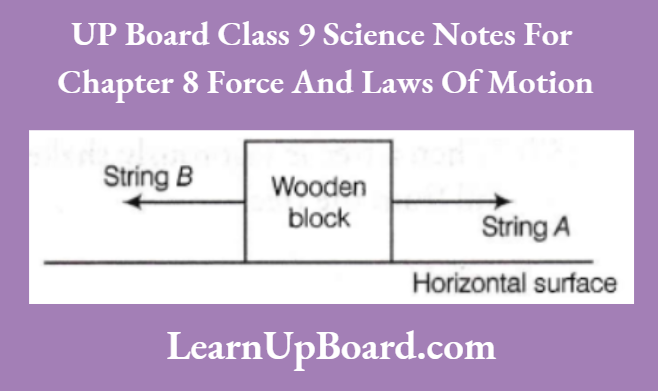
If we pull A and B strings with equal magnitude of forces, then the block does not change its state of rest. Such types of forces are known as balanced forces.
Unbalanced Forces
When the net effect produced by several forces acting on a body is non-zero, then the forces are said to be unbalanced forces. A boy wants to relocate the refrigerator in his house as shown
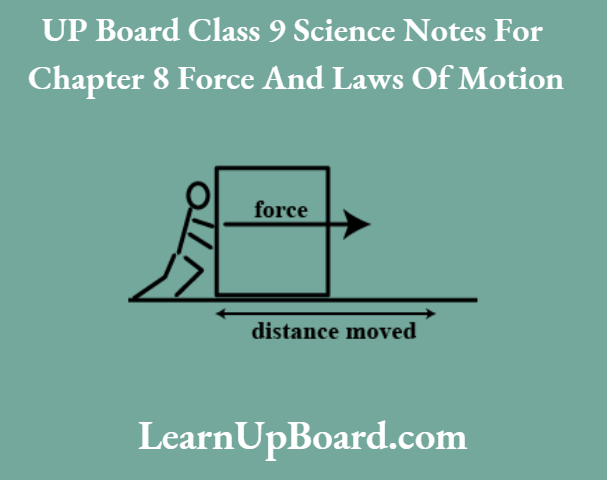
He pushes the refrigerator with a small force, the refrigerator does not move due to frictional force acting in a direction opposite to the push. If he pushes the refrigerator harder, then the pushing force becomes more than the friction, and due to this, the refrigerator starts moving in the direction of push as shown in the figure.
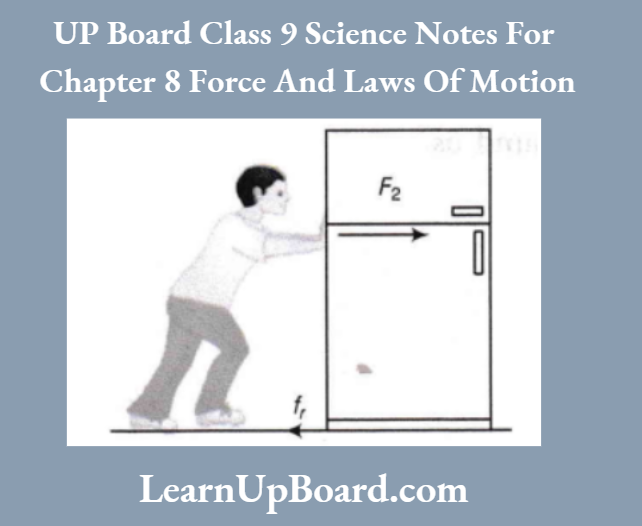
In the above example, there is an unbalanced force that causes motion in the refrigerator. The unbalanced forces cause a change in the state of rest or of uniform motion of a body.
For Example, In a tug of war when one of the teams suddenly releases the rope, then an unbalanced force acts on the other team due to which it falls backward.
If an unbalanced force is applied to a moving object, there will be a change either in its speed or in the direction of its motion. Thus, to accelerate the motion of an object, an unbalanced force is required
UP Board Class 9 Science Notes For Chapter 8 Newton’s Laws Of Motion
Newton studied the ideas of Galileo regarding the motion of an object. He formulated three fundamental laws that govern the motion of objects. These three laws are known as Newton’s laws of motion, which are as given below:
Newton’s First Law of Motion
It states that an object will continue to remain in its state of rest or of uniform motion along a straight line path unless an external force acts on it. This means all objects resist change in their state.
The state of any object can be changed by applying external forces only.
(1) A person standing on a bus falls backward when the bus starts moving suddenly. This happens because the person and bus both are at rest while the person is not moving as the bus starts moving. The legs of the person start moving along with the bus, but the rest portion of his body tends to remain at rest. Because of this, a person falls backward if he is not alert.
(2) A person standing in a moving bus falls forward if the driver applies brakes suddenly.
Inertia
The unwillingness (or inability) of an object to change its state of rest or uniform motion along a straight line is called the inertia of the object.
It is the inherent property of all the objects. Newton’s first law of motion is also known as Galileo’s law of inertia.
The inertia of an object is measured by its mass. Inertia is directly proportional to the mass. It means that inertia increases with an increase in mass and decreases with a decrease in mass. A heavy object will have more inertia than a lighter one.
Types of Inertia
Inertia is divided into three types as given below:
1. Inertia of rest The tendency of a body to oppose any change in its state of rest is known as inertia of rest. For Example.
- When a bus suddenly starts moving forward, then the passengers in the bus fall backward.
- The carpet is beaten with a stick to remove the dust particles.
- When a tree is vigorously shaken, then some of the leaves fall from the tree.
2. Inertia of motion The tendency of a body to oppose any change in its state of uniform motion is known as inertia of motion, For Example.
- The passengers fall forward when a fast-moving bus stops suddenly.
- A person falls forward while getting down from a moving bus or train.
- Luggage is usually tied with a rope on the roof of a bus.
3. Inertia of direction The tendency of a body to oppose any change in its direction of motion is known as inertia of direction, For Example.
- When a fast-moving bus negotiates a curve on the road, then passengers fall away from the center of the curved road.
- The sparks produced during the sharpening of a knife against a grinding wheel leave tangentially to its rim.
- A stone tied to a string is whirling in a horizontal circle. If the string breaks, then the stone flies away tangentially.
Momentum
Momentum measures the quantity of motion possessed by a body. It is defined as the product of the mass and velocity of the body. Besides magnitude, momentum also has a direction.
At any instant, its direction is the same as the direction of the velocity. If a body of mass m moves with a velocity v, then momentum p is given by p=mv
The SI unit of momentum is kg-m/s.
Example 1. A car of mass 1000 kg is moving with a velocity of 72 km/h. Find its momentum.
Answer:
Given,
A car of mass 1000 kg is moving with a velocity of 72 km/h
mass, m = 1000 kg
Velocity, v=72 km/h =72 \(\times \frac{5}{18}\)=20 m /s and Momentum, p= ?
Momentum = Mass x Velocity => p – mv p =1000 x 20 = 20000 kg-m/s Thus, the momentum of the car is 20000 kg-m/s.
Newton’s Second Law of Motion
The second law of motion states that the rate of change of momentum of an object is directly proportional to the applied external force and takes place in the direction in which external force acts.
Mathematical Formulation of the Second Law of Motion
If a body of mass m moving at initial velocity u accelerates uniformly with an acceleration a for time t, so that its final velocity changes to v, then
Initial momentum, \(p_1\)= mu
Final momentum, \(p_2\)= mv
Change in momentum = \(p_2-p_1\) = mv – mu = m(v-u)
According to the second law of motion,
Force, F \(\propto \frac{\text { change in momentum }}{\text { time }}\)
⇒ \(F \propto \frac{p_2-p_1}{t} \Rightarrow F \propto \frac{m(v-u)}{t}\)
⇒ \(F \propto m a [\frac{v-u}{t}=a]\)
F = k ma
The quantity k is a constant of proportionality.
One unit of force is defined as the amount that produces an acceleration of 1 \(\mathrm{~m} / \mathrm{s}^2\) on an object of 1 kg mass.
i.e. 1 unit of force =k \(\times 1 \mathrm{~kg} \times 1 \mathrm{~m} / \mathrm{s}^2 \Rightarrow k=1\)
Thus, the force can be written as F =ma
The SI unit of force is Newton, which is denoted by the symbol N and it is equivalent to kg-m/s2.
When the applied force F is zero, then the acceleration a is also zero and the body remains in its state of rest or of a uniform motion.
Applications of Newton’s Second Law of Motion
The following applications are based on Newton’s second law of motion:
- A cricket player (or fielder) moves his hands backward while catching a fast cricket ball.
- During athletics meets, athletes doing the high jump and long jump land on foam or a heap of sand to decrease the force on the body, and the landing is comfortable.
Newton’s First Law from Mathematical Expression of Second Law
The first law of motion can be mathematically stated from the mathematical expression of the second law of motion.
As we know, F = ma
F=\(\frac{m(v-u)}{t} [a=\frac{(v-u)}{t}]\)
Ft = mv – mu
From this equation, if F = 0, then v = u for any value of time. This means that, in the absence of an external force, the object will continue moving with uniform velocity u throughout the time t and if u is zero, then v will also be zero, i.e. the object will remain at rest.
Example 2. The force acts on an object of mass 4 kg and changes its velocity from 10 m/s to 20 m/s in 5 s. Find the magnitude of force.
Answer:
Given,
The force acts on an object of mass 4 kg and changes its velocity from 10 m/s to 20 m/s in 5 s
The mass of an object, m = 4 kg
Initial velocity, u = 10 m/s; Final velocity, v = 20 m/s Time taken, t = 5 s
We know that, Newton’s first law of motion,
v = u + at or a=\(\frac{v-u}{t}\)
a=\(\frac{20-10}{5}=\frac{10}{5}=2 \mathrm{~m} / \mathrm{s}^2\)
Magnitude of force, F = Mass x Acceleration
F =ma = 4kgx2 m/s² = 8 N Hence, the magnitude of the force is 8 N.
Example 3. A force of 50 N acts on a stationary body of mass 10 kg for 2 s. Find the acceleration produced in the body and the velocity attained by it.
Answer:
Given
A force of 50 N acts on a stationary body of mass 10 kg for 2
Initial velocity, u- 0 [since the body is stationary]
Force, F – 50 N, mass, m —10 kg, time, t = 2 s
Final velocity, v = ?, acceleration, a = ? v -u
Acceleration, a=\(\frac{v-u}{t}\)
a=\(\frac{10-0}{2}=5 \mathrm{~m} / \mathrm{s}^2\)
Final velocity,v = \(\frac{F t}{m}+u {[F t=m(v-u)]}\)
v=\(\frac{50 \times 2}{10}+0=10 \mathrm{~m} / \mathrm{s}\)
Thus, the acceleration produced in the body is 5 \(\mathrm{~m} / \mathrm{s}^2\), and the velocity attained by it is 10 m/s.
Example 4 A bullet train is moving with a velocity of 180 km/h and it takes 5 s to stop after the brakes are applied. Find the force exerted by the brakes on the wheel of the train if its mass with the wagon is 2000 kg.
Answer:
Given,
A bullet train is moving with a velocity of 180 km/h and it takes 5 s to stop after the brakes are applied.
initial velocity u=180 km/h =180 \(\times \frac{5}{18}\)=50 m/s
Final velocity v=0,
time t=5 s , mass m = 2000 kg
From the first equation of motion,
v=u+a t
u=-a t
a=-\(\frac{u}{t}=\frac{-50}{5}=-10 \mathrm{~m} / \mathrm{s}\)
Now, the force exerted by the brakes on the wheel is given by Newton’s second law F – ma – 2000 x -10 = -20000 N Negative sign shows that the direction of force is opposite to the motion of the body.
Example 5. A force of 6N gives a mass mv an acceleration of 18 m/s² and a mass m², an acceleration of 24 m/s². What acceleration would it give if both the masses were tied together?
Answer:
Given,
A force of 6N gives a mass mv an acceleration of 18 m/s² and a mass m², an acceleration of 24 m/s².
force F =6N
Acceleration of mass mx, ax =18 m/s² Acceleration of mass w², a² = 24 m/s²
Acceleration is produced when both masses are tied together a -?
From Newton’s second law of motion Reaction Ground ;
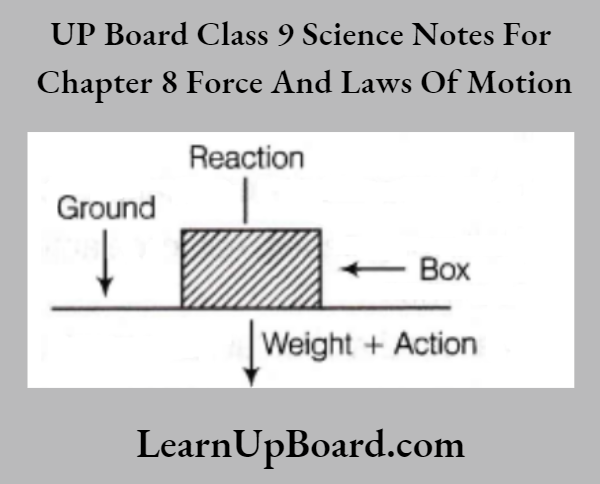
⇒ \(m_1=\frac{F}{a_1}=\frac{6}{18}=\frac{1}{3} \mathrm{~kg}\)
⇒ \(m_2=\frac{F}{a_2}=\frac{6}{24}=\frac{1}{4} \mathrm{~kg}\)
Total mass m=\(m_1+m_2=\frac{1}{3}+\frac{1}{4}=\frac{4+3}{12}=\frac{7}{12} \mathrm{~kg}\)
Acceleration produced in combined mass a=\(\frac{F}{m}\)
a=\(\frac{6}{7 / 12}=\frac{12 \times 6}{7}=10.28 \mathrm{~m} / \mathrm{s}^2\)
Example 6. The velocity-time graph of a ball of mass 30 g moving along a straight line on a long table is given figure. How much force does the table exert on the ball to bring it to rest?
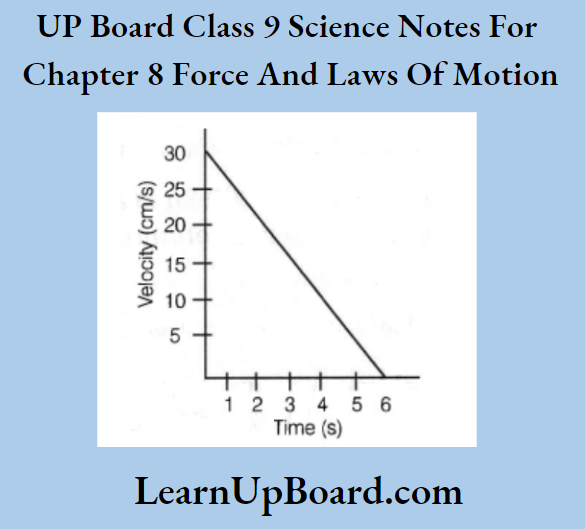
Answer:
Given
The velocity-time graph of a ball of mass 30 g moving along a straight line on a long table is given figure.
The initial velocity of the ball =30 cm/s
Final velocity v=0 and Time t=6 s
Acceleration a=\(\frac{v-u}{t}=\frac{(0-30)}{6}=-5 \mathrm{~cm} / \mathrm{s}^2=-0.05 \mathrm{~m} / \mathrm{s}^2\)
The force exerted on the ball, F = ma
F = ma =\(\left(\frac{30}{1000}\right) \times(-0.05)=-1.5 \times 10^{-3} \mathrm{~N}\)
The negative sign shows that the frictional force exerted by the table is opposite to the direction of motion of the ball.
Impulse
It is termed as the total impact of force. This is equal to the change in momentum of the body. In other words, impulse is defined as the product of force and a small time in which force acts.
According to Newton’s second law, F =ma
F=\(\frac{m(v-u)}{t}\)
F=\(\frac{m v-m u}{t}\)
Ft = mv – mu
Impulse, I=F t=\(p_2-p_1\)
or Impulse = Change in momentum
The SI unit of impulse is N-s or kg – m/s
Example 7. If a force of 1000 N is applied over a vehicle of 500 kg, then for how much time the velocity of the vehicle will increase from 2 m/s to 10 m/s? Also, find the impulse.
Answer:
Given,
A force of 1000 N is applied over a vehicle of 500 kg,
F = 1000 N, mass m = 500 kg
Final velocity =10 m/s
Initial velocity u = 2 m/s
F=\(\frac{m(v-u)}{t}\)
t=\(\frac{m(v-u)}{F}=\frac{500 \times(10-2)}{1000}=4 \mathrm{~s}\)
Impulse I = Ft =1000 x 4 = 4000 N-s
Thus, the time required by the vehicle is 4s, and its impulse is 4000 N-s.
Newton’s Third Law of Motion
The third law of motion states that, whenever one object exerts a force on another object, then the second object exerts an equal and opposite force on the first object.
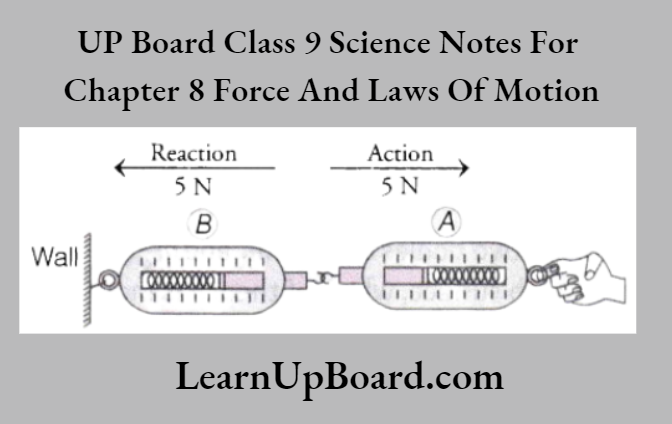
Spring balance action and reaction forces are equal and opposite
Thus, action and reaction forces are equal in magnitude and opposite in direction. They still do not cancel each other’s effect because they act on different objects.
Applications of Newton’s Third Law of Motion
- Collision of two persons If two persons walking or running in opposite directions collide with each other, then both feel hurt because they apply force to each other. Two opposing forces are in action and reaction pairs.
- Walking of a person A person is able to walk because of Newton’s third law of motion. During walking, a person pushes the ground in a backward direction, and in the reaction, the ground also pushes the person with an equal magnitude of force but in the opposite direction. This enables him to move in the forward direction against the push.
- The recoil of a gun When a bullet is fired from a gun, then the bullet also pushes the gun in the opposite direction with an equal magnitude of force. Since the gun has a greater mass than a bullet, the acceleration of the gun is much less than the acceleration of the bullet.
- Propulsion of a boat in a forward direction Sailor pushes water with oar in a backward direction resulting in water pushing the oar in the forward direction. Consequently, the boat is pushed in the forward direction. The force applied by oar and water are of equal magnitude but in opposite directions.
- Rocket propulsion The propulsion of a rocket is based on the principle of action and reaction. The rapid burning of fuel produces hot gases which rush out from the nozzle at the rear end at a very high speed. The equal and opposite reaction force moves the rocket upward at a great speed.
UP Board Class 9 Science Notes For Chapter 8 Activity 1
Objective: To demonstrate the property of inertia of rest using carom board and coin.
Materials Required:
- Carom board
- Carom coins
Procedure
- Make a pile of similar carom coins on a carom board as shown.
- Attempt a sharp horizontal hit at the bottom of the pile using another carom coin or the striker.
- If the hit is strong enough, the bottom coin moves out quickly.
- Once the lowest coin is removed, the inertia of the other coins makes them fall vertically on the table.
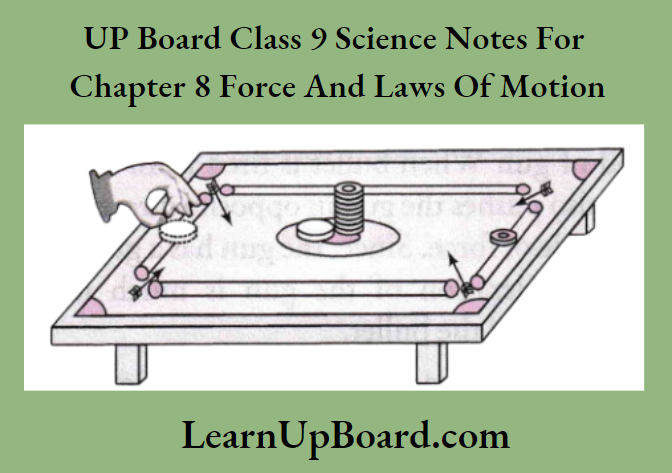
Discussion/Conclusion
- If the hit is strong enough, the bottom coin moves quickly on the carom table without disturbing the upper carom coins. Once the lowest coin is removed, the upper carom coins fall vertically on the table due to the inertia of rest.
- If the hit is weak, the disturbance may be communicated to upper carom coins, which may fall randomly with or without the actual movement of the coin.
Question 1. What does the Inertia of an object tend to cause?
Answer:
The inertia of an object tends to resist any change in its state of rest or motion.
Question 2. What happens if the hit is weak?
Answer:
If the hit is weak, the upper carom coins may fall randomly with or without actual movement of the coin.
Question 3. On what factor does the inertia of a body depend?
Answer:
The inertia of the body depends on the mass of the body.
UP Board Class 9 Science Notes For Chapter 8 Activity 2
Objective: To demonstrate the property of inertia of rest using glass and coins.
Materials Required:
- Glass tumbler
- Stiff card
- Five-rupees coin
- Table
Procedure
- Set a five-rupee coin on a stiff card covering an empty glass tumbler, standing on a table.
- Give a sharp horizontal flick to the card with a finger. If we do it fast, then the card shoots away allowing the coin to fall vertically into the glass tumbler due to its inertia.
- The inertia of the coin tries to maintain its state of rest even when the card flows off.
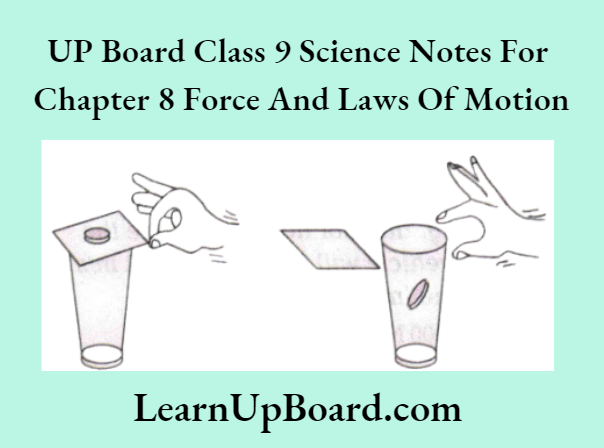
Discussion/Conclusion
When the card is given a sharp horizontal flick with a finger, the card underneath the five-rupee coin shoots away. The coin falls vertically into the glass tumbler due to the inertia of the rest.
The basic thing is that force is applied to the card. This is why the coin tends to remain at rest.
Question 1. Which law is associated with this activity?
Answer:
Newton’s first law of motion is associated with it.
Question 2. Name the concept involved in this activity.
Answer:
The concept of inertia is involved in this activity.
Question 3. There are two bodies of mass m2 >m2) present on a rough surface, which of them has more inertia and why?
Answer:
Since, m1 > m2, so mass m1 has more inertia than m2.
UP Board Class 9 Science Notes For Chapter 8 Activity 3
Objective: To demonstrate the forces of action and reaction are equal and opposite by throwing the bag full of sand.
Materials Required
- Two students
- Two carts
- A bag full of sand
- White paint
Procedure
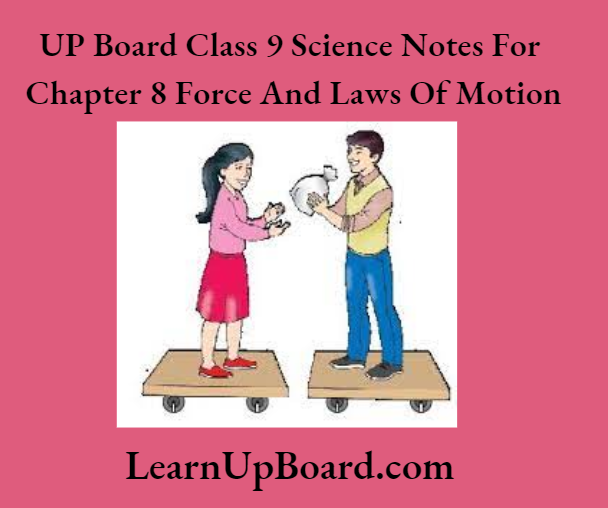
- Request two children to stand on two separate carts
- Give them a bag full of sand. Ask them to play a game of catching the bag.
- Does each of them receive an instantaneous reaction as a result of throwing the sandbag (action)?
- You can paint a white line on cartwheels to observe the motion of the two carts when the children throw the bag towards each other.
Discussion/Conclusion
Yes, in this case, each of them receives an instantaneous reaction as a result of throwing the sandbag. When the boy throws the bag towards the girl, the cart of the boy moves back. Similarly, when the girl throws the bag towards the boy, the cart of the girl moves back.
Thus, it explains Newton’s third law of motion, i.e. the force is exerted forward in throwing the bag, and the person who is throwing it gets pushed backward. Action and reaction are taking place simultaneously on two different bodies.
Question 1. What happens to the cart when the two children are playing the game of catching the bag?
Answer:
The cart of each child moves outwards when both the children are playing the game of catching the bag.
Question 2. Name the type of reaction involved in throwing the bag.
Answer:
An instantaneous type of reaction is involved in throwing the bag.
Question 3. Are the forces of action and reaction equal?
Answer:
Yes, the forces of action and reaction are equal in magnitude but opposite in direction.
UP Board Class 9 Science Notes For Chapter 8 Force And Laws Of Motion Question And Answers
Question 1. Which of the following has more inertia?
- A rubber ball and a stone of the same size
- A bicycle and a train
- A five-rupees coin and a one-rupee coin
- Give reasons for your answer.
Answer:
- The inertia of an object is proportional to its mass.
- A stone of the same size as a of rubber ball will have greater mass, so the stone will have more inertia.
- A train has much greater mass than of a bicycle, so the train will have more inertia.
- A five-rupee coin has more mass than a one-rupee coin, so a five-rupee coin will have greater inertia.
Question 2. In the following example, try to identify the number of times the velocity of the ball changes.
A football player kicks a football to another player of his team who kicks the football towards the goal. The goalkeeper of the opposite team collects the ball and kicks it towards a player of his team. Also, identify the agent supplying the force in each case.
Answer:
There are several times at which the direction and magnitude of velocity of the ball changes, which are as given below:
Whenever a force is applied to the ball, then the velocity of the ball will change.
- When the first player kicks the ball toward another player of his team, then the velocity of the ball will change because the first player applies some force on the ball.
- When another player kicks the ball toward the goal, then the velocity of the ball will change, here again, the force is applied to the ball.
- When the goalkeeper of the opposite team collects the ball, then the velocity of the ball will be changed, it becomes zero. Here, the goalkeeper applies some force on the ball to stop.
- When the goalkeeper kicks the ball towards his own team, then the velocity of the ball changes because the goalkeeper applies some force on the ball.
Question 3. Explain, why some of the leaves may get detached from a tree, if we vigorously shake its branch.
Answer:
Leaves have the inertia of rest. When the branch is shaken, it tends to remain in the same state and gets detached when the position of the branch changes.
Question 4. Why do you fall in the forward direction when a moving bus breaks to a stop and fall backward when it accelerates from rest?
Answer:
When the moving bus brakes to a stop, then the passengers who had inertia of motion, oppose a change in their state. However, the lower portion of their body in contact with the bus comes to rest.
So, they fall forward. When the bus accelerates from rest, then the passengers who had inertia of rest, oppose a change in their state. However, the lower portion of their body starts moving with the bus. Hence, they fall backward.
Question 5. If action is always equal to the reaction, then explain how a horse can pull a cart.
Answer:
The horse pushes the ground in a backward direction. The ground exerts a reaction force on the horse and cart system to push them forward.
When the reaction force exceeds the force of friction between the wheels of the cart and the ground, then the cart is pushed forward.
Question 6. Explain, why is it difficult for a fireman to hold a hose pipe, which ejects a large amount of water with a high velocity.
Answer:
A fireman finds it difficult to hold a hose-pipe which is ejecting a large amount of water at high velocity. Because the stream of water rushing out of the pipe in the forward direction exerts a large force on the pipe.
Due to the reaction of the forward force, a force is applied to the pipe in the backward direction. Therefore, the fireman struggles to keep the hose pipe at rest.
UP Board Class 9 Science Notes For Chapter 8 Exercises
Question 1. An object experiences a net zero external unbalanced force. Is it possible for the object to be traveling with a non-zero velocity? If yes, state the conditions that must be placed on the magnitude and direction of the velocity. If no, provide a reason.
Answer:
As per Newton’s first law of motion, no force is needed to move an object that is already moving with a constant (non-zero) velocity. So, when an object experiences a net zero external unbalanced force, then it can move with a non-zero velocity. When an external force is zero then the velocity of the object remains the same both in magnitude and direction.
Question 2. When a carpet is beaten with a stick, dust comes out of it. Explain.
Answer:
When a carpet is beaten with a stick, then the fibers of the carpet attain the state of motion while the dust particles remain at rest due to the inertia of rest, and hence dust particles get detached.
Question 3. Why is it advised to tie any luggage kept on the roof of a bus with a rope?
Answer:
- When the bus stops suddenly, the bus comes to a state of rest but the luggage remains in a state of motion. So, due to inertia of motion, the luggage moves forward and may fall down from the roof of the bus.
- If the bus starts suddenly, then the bus comes in a state of motion but the luggage remains in the state of rest. Due to the inertia of rest, the luggage does not move in the forward direction and may fall down.
Question 4. A batsman hits a cricket ball which then rolls on a level ground. After covering a short distance, the ball comes to rest. Why does the ball slow down to stop?
- The batsman did not hit the ball hard enough
- Velocity is proportional to the force exerted on the ball
- There is a force on the ball opposing the motion
- There is no unbalanced force on the ball, so the ball would want to come to rest.
Answer:
The ball slows down to stop because the force of friction between the ground and the ball acts as an external force that opposes the motion of the ball.
Question 5. A truck starts from rest and rolls down a hill with a constant acceleration. It travels a distance of 400 m in 20 seconds. Find its acceleration. Find the force acting on it, if its mass is 7 tonne.
(Hint: 1 tonne = 1000 kg)
Answer:
Given
A truck starts from rest and rolls down a hill with a constant acceleration. It travels a distance of 400 m in 20 seconds.
The truck starts from rest, so initial velocity, u = 0,
Distance, s = 400 m , Time, t = 20 s Mass, m – 1 tonne = 7 x 1000 = 7000 kg
From Newton’s second law of motion, s=u t+\(\frac{1}{2} a t^2\)
400 =0 \(\times 20+\frac{1}{2} \times a \times(20)^2\)
400 =200 a
a =2 \(\mathrm{~m} / \mathrm{s}^2\)
From Newton’s second law of motion, the force acting on the truck,
F=m a=7000 \(\times 2 =14000 \mathrm{~N}\)
=1.4 \(\times 10^4 \mathrm{~N}\)
Thus, the acceleration of the truck is 2 m \(s^2\), and the force acting on it is 1.4 \times 10^4 N.
Question 6. A stone of size 1 kg is thrown with a velocity of 20 m/s across the frozen surface of a lake and comes to rest after traveling a distance of 50 m. What is the force of friction between the stone and the ice?
Answer:
Given,
A stone of size 1 kg is thrown with a velocity of 20 m/s across the frozen surface of a lake and comes to rest after traveling a distance of 50 m.
the mass of the stone, m-1 kg,
Initial velocity, u = 20 m/s
Final velocity, v = 0 [since stone comes to rest]
Distance covered, s = 50 m
From Newton’s third law of motion, v² = u² + 2as
(0)² =(20)² + la (50)
⇒ 100 a =-400
⇒ a = – 4 m/s²
Here, a negative sign shows that there is a retardation in the motion of the stone.
Force of friction between stone and ice = Force required to stop the stone
= ma – 1 x (-4) = – 4 N
Question 7. An 8000 kg engine pulls a train of 5 wagons, each of 2000 kg along a horizontal track. If the engine exerts a force of 40000 N and the track offers a friction force of 5000 N, then calculate
- The net accelerating force.
- The acceleration of the train and
- The force of wagon 1 on wagon 2.
Answer:
Given
An 8000 kg engine pulls a train of 5 wagons, each of 2000 kg along a horizontal track. If the engine exerts a force of 40000 N and the track offers a friction force of 5000 N,
(1) Net accelerating force = Force exerted by the engine -Friction force
[Here, frictional force is subtracted because it opposes the motion]
= 40000 -5000 =35000 = 3.5 x 104 N
(2) From Newton’s second law of motion,
Accelerating force = mass of the train x acceleration of train F
a =\(\frac{F}{m}\)
Mass of train =5 x Mass of one wagon
=5 x 2000=10000 kg
Acceleration =\(\frac{35000}{10000}=3.5 \mathrm{~m} / \mathrm{s}^2\)
(3) Force of wagon 1 on wagon 2
=(35000-3.5×2000) N = 28000 N
Question 8. An automobile vehicle has a mass of 1500 kg. What must be the force between the vehicle and road, if the vehicle is to be stopped with a negative acceleration of 1.7 m/s²?
Answer:
Given,
An automobile vehicle has a mass of 1500 kg.
mass, m~ 1500 kg, acceleration, = – 1.7 m/s²
From Newton’s second law of motion,
F = ma – 1500 x (-1.7) = -2550N
Question 9. What is the momentum of an object of mass m moving with a velocity v?
- \(m^2 v^2\)
- \(m v^2\)
- \(\frac{1}{2} m v^2\)
- mv
Answer: 4. mv
The momentum of an object of mass m moving with a velocity v is given by p = mv.
Question 10. Using a horizontal force of 200 N, we intend to move a wooden cabinet across a floor at a constant velocity. What is the friction force that will be exerted on the cabinet?
Answer:
The cabinet will move across the floor with constant velocity if there is no net external force applied to it. Here, a horizontal force of 200 N is applied to the cabinet, so for the net force to be zero, an external force of 200 N should be applied to the cabinet in the opposite direction.
Thus, the frictional force = 200 N [frictional force always acts in the direction opposite to the direction of motion]
Question 11. According to the third law of motion when we push an object, the object pushes back on us with an equal and opposite force. If the object is a massive truck parked along the roadside, it will probably not move. A student justifies this by answering that the two opposite and equal forces cancel each other. Comment on this logic and explain why the truck does not move.
Answer:
- The logic given by the student is not correct because two equal and opposite forces cancel each other only in the case that they act on the same body. Action and reaction force always act on two different bodies, so they cannot cancel each other.
- When a massive truck is pushed, then the truck may not move because the force applied is not sufficient to overcome the force produced by friction acting opposite to the applied force to move the truck.
Question 12. A bullet of mass 10 g traveling horizontally with a velocity of 150 m/s strikes a stationary wooden block and comes to rest in 0.03 s. Calculate the distance of penetration of the bullet into the block. Also, calculate the magnitude of the force exerted by the wooden block on the bullet.
Answer:
Given,
A bullet of mass 10 g traveling horizontally with a velocity of 150 m/s strikes a stationary wooden block and comes to rest in 0.03 s.
the mass of the bullet,
m =10 g
= \(\frac{10}{1000} \mathrm{~kg}=0.01 \mathrm{~kg}\)
Initial velocity, u= 150m/s
Final velocity, v = 0 [since bullet comes to rest]
Time, t = 0.03 s
From Newton’s first law of motion, v = u + at 0 =150+ a x 0.03
a=\(\frac{-150}{0.03}=-5000 \mathrm{~m} / \mathrm{s}^2\)
Distance covered by the bullet before coming to rest is given by \(v^2=u^2+2 a s\)
0 =\((150)^2+2(-5000) \mathrm{s}\)
s \(\frac{(150)^2}{10000}=2.25 \mathrm{~m}\)
The magnitude of the force applied by the bullet on the block,
F = ma= 0.01 x -5000 = -50 N
Question 13. An object of mass 100 kg is accelerated uniformly from a velocity of 5 m/s to 8 m/s in 6 s. Calculate the initial and final momentum of the object. Also, find the magnitude of the force exerted on the object.
Answer:
Given,
An object of mass 100 kg is accelerated uniformly from a velocity of 5 m/s to 8 m/s in 6 s.
Mass of the object, m = 100 kg Initial velocity, u = 5 m/s Final velocity, v = 8 m/s,
Time, t = 6 s
(1) Initial momentum = mu
= 100 x 5 = 500 kg – m / s and final momentum = mv
= 100 x 8 = 800 kg – m / s
(2) From Newton’s second law, the force exerted on the object = rate of change of momentum = Change in momentum
=\(\frac{\text { Change in momentum }}{\text { Time }}\)
=\(\frac{\text { Final momentum }- \text { Initial momentum }}{\text { Time }}\)
=\(\frac{800-500}{6}=\frac{300}{6}=50 \mathrm{~N}\)
Question 14. Akhtar, Kiran, and Rahul were riding on a motorcar that was moving with a high velocity on an expressway when an insect hit the windscreen. Akhtar and Kiran started pondering over the situation. Kiran suggested that the insect suffered a greater change in momentum as compared to the change in momentum of the motorcar.
Akhtar said that, since the motorcar was moving with a larger velocity, it exerted a larger force on the insect and as a result insect died. Rahul while putting an entirely new explanation said that both the motorcar and the insect experienced the same force and change in their momentum. Comment on these suggestions.
Answer:
- According to the law of conservation of momentum, the momentum of the car and insect system before collision = momentum of the car and insect system after collision
- Hence, the change in momentum of the car and insect system is zero. The insect gets stuck on the windscreen. This means that the direction of the insect is reversed. As a result, the velocity of the insect changes by a great amount.
- On the other hand, the car continues moving with a constant velocity. Kiran’s suggestion is wrong.
- Akhtar made a correct conclusion because the mass of the car is very large compared to the mass of the insect. Rahul gave a correct explanation.
Question 15. How much momentum will a dumbbell of mass 10 kg transfer to the floor, if it falls from a height of 80 cm? Take, its downward acceleration to be 10 m/s².
Answer:
Given the mass of the dumb-bell, m = 10 kg
Initial velocity, u = 0 [because it falls from rest]
Distance covered, s = 80 cm = 0.8 m
Acceleration, a = 10 m/s²
From Newton’s third law of motion,
v² =u² + 2 as
v²= 0 + 2 x 10 x 0.8 =16 ⇒ = -v 16 = 4 m/s
The momentum of the dumbbell just before it touches the floor is given by p = mv = 10 x 4 = 40 kg-m/s When the dumbbell touches the floor, then its velocity becomes zero and hence the momentum. Thus, the total momentum of the dumbbell is transferred to the floor.
So, the momentum transferred to the floor is 40 kg- m/s
Question 16. The following is the distance-time table of an object in motion:
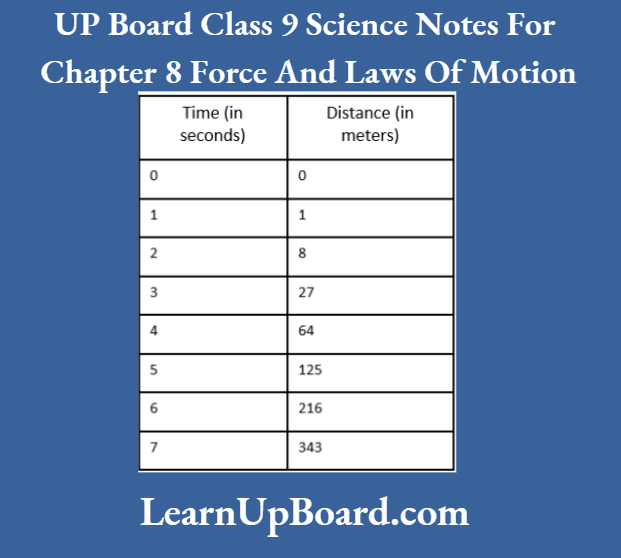
- What conclusion can you draw about the acceleration? Is it constant, increasing, decreasing or zero?
- What do you infer about the force acting on the object?
Answer:
(1) Here, initial velocity, u=0
Using Newton’s second law of motion,
s=u t+\(\frac{1}{2} a t^2=\frac{1}{2} a t^2 [ u=0]\)
We get, a=\(\frac{2 s}{t^2}\)

Thus, acceleration is increasing.
(2) Since, acceleration is increasing, so net unbalanced force is acting on the object.
Question 17. Two persons manage to push a motorcar of mass 1200 kg at a uniform velocity along a level road. The same motorcar can be pushed by three persons to produce an acceleration of 0.2 m/s². With what force does each person push the motorcar? (Assume that all persons push the motorcar with the same muscular effort.)
Answer:
Given,
Two persons manage to push a motorcar of mass 1200 kg at a uniform velocity along a level road. The same motorcar can be pushed by three persons to produce an acceleration of 0.2 m/s².
the mass of the motorcar, m =1200 kg
Acceleration produced, a = 0.2 m/s²
Force applied on the car by three persons,
F = ma = 1200 x 0.2 = 240 N
Force applied on the car by one person = \(\frac{240}{3}\) = 80 N
Each person pushes the motorcar with a force of 80 N.
Question 18. A hammer of mass 500 g moving at 50 m/s strikes a nail. The nail stops the hammer in a very short time of 0.01 s. What is the force of the nail on the hammer?
Answer:
Given,
A hammer of mass 500 g moving at 50 m/s strikes a nail. The nail stops the hammer in a very short time of 0.01 s.
Mass of the hammer = 300 g= 0.5 kg
The initial velocity of the hammer, u = 50 m/s
The final velocity of the hammer, v = 0 [because the hammer stops]
Time, t = 0.01 s
According to Newton’s second law of motion, the force of the nail on the hammer = rate of change of momentum of the hammer
= \(\frac{m v-m u}{t}=\frac{0.5 \times 0-0.5 \times 50}{0.01}\)
= \(-\frac{25}{0.01}=-2500 \mathrm{~N}\)
The force of the nail on the hammer is equal and opposite to that of the hammer on the nail.
Question 19. A motorcar of mass 1200 kg is moving along a straight line with a uniform velocity of 90 km/h. its velocity is slowed down to 18 km/h in 4 s by an unbalanced: external force. Calculate the acceleration and change in momentum. Also, calculate the magnitude of the force required
Answer:
Given,
A motorcar of mass 1200 kg is moving along a straight line with a uniform velocity of 90 km/h. its velocity is slowed down to 18 km/h in 4 s by an unbalanced: external force.
mass, m =1200 kg
Initial velocity, u=90 \(\mathrm{~km} / \mathrm{h}=90 \times \frac{5}{18}=25 \mathrm{~m} / \mathrm{s}\)
Final velocity, v=18 \(\mathrm{~km} / \mathrm{h}=18 \times \frac{5}{18}=5 \mathrm{~m} / \mathrm{s}\)
Time, t=4 s
(1) Acceleration, a=\(\frac{v-u}{t}=\frac{5-25}{4}\)
=-\(\frac{20}{4}=-5 \mathrm{~m} / \mathrm{s}^2\) [here, the negative sign indicates that the velocity decreases]
(2) Change in momentum
= Final momentum – Initial momentum
= m v-m u=m(v-u)
= 1200(5-25)
= 1200 \(\times(-20)=-24000 \mathrm{~kg}-\mathrm{m} / \mathrm{s}\)
(3) Magnitude of the force required
= Rate of change of momentum
=\(\frac{\text { Change in momentum }}{\text { Time }}\)
=\(\frac{-24000}{4}=-6000 \mathrm{~N}\)
UP Board Class 9 Science Notes For Chapter 8 Summary
Any action which causes pull, hit, or push on a body is called force. Types of forces
- Balanced forces When the net effect produced by many forces acting on a body is zero, then the forces are said to be balanced forces.
- Unbalanced forces When the net effect produced by many forces acting on a body is non-zero, then the forces are said to be unbalanced forces.
- Newton’s first law of motion States that an object will continue to remain in its state of rest or in a uniform motion along a straight line or path unless an external force acts on it.
- The unwillingness (or inability) of an object to change its state of rest or of uniform motion along a straight line is called the inertia of the object.
Types of inertia
- The inertia of Rest The tendency of a body to oppose any change in its state of rest is known as the inertia of rest.
- The inertia of Motion The tendency of a body to oppose any change in its state of uniform motion is known as the inertia of motion.
- The inertia of Direction The tendency of a body to oppose any change in its direction of motion is known as the inertia of direction
Momentum Measures the quantity of motion possessed by a body. It is defined as the product of the mass and velocity of the body.
Momentum, p = mv
The SI unit of momentum is kg-m/s.
Newton’s second law of motion States that the rate of change of momentum of an object is proportional to the applied external force and takes place in the direction in which external force acts.
Force applied on an object is equal to the product of the mass of the object and acceleration produced in it. Force, F = ma
The SI unit of force is Newton (N).
Impulse is defined as the product of force and the small time in which the force acts.
Impulse, I = Ft – p2 – p1 or Impulse = Change in momentum The SI unit of impulse is N-s or kg-m/s.
Newton’s third law of motion States that whenever one object exerts a force on another object, then the second object exerts an equal and opposite force on the first object.
